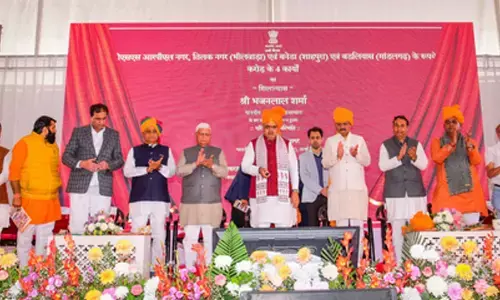JO DIKHTA, WO BIKTA

Despite the cynical comment one often hears: “what have governments done since independence? There is neither growth nor development!” In the same breath, people admit rise income levels, especially among middle class. Over the last seven decades, especially on account of the rainbow of revolutions
Despite the cynical comment one often hears: “what have governments done since independence? There is neither growth nor development!” In the same breath, people admit rise income levels, especially among middle class. Over the last seven decades, especially on account of the rainbow of revolutions – green, white, yellow and blue in the agriculture, milk, oil seeds and fisheries sectors respectively – the country has witnessed a great deal of economic growth.
Many educational institutions such as the Indian Institutes of Management (IIMs) and the Indian Institutes of Technology (IITs), National Institutes of Technology (NITs), engineering and medical colleges etc., have brought out the best in the Indian youth who have gone abroad, and through their remittances, improved the living conditions of their parents.
Over the last seven decades many other good things have also happened in independent India.
The bloodless struggle for independence, the performance of institutions such as the higher levels of Judiciary, the Election Commission and the Union Public Service Commission etc., have also filled our hearts with pride. Similarly, expeditions to the Arctic and exploring other planets and the way we have fared in many sports such as chess, badminton, tennis and cricket have also added to the sense of pride an Indian feels in being called a citizen of this great coun¬try.
These developments, among many others, have triggered a rapidly growing purchasing power of a large section of our population. In fact, some of the largest and most well spread networks retail networks of the developed countries in many fields including consumer durables, food, jewellery, garments etc., have responded to high hopes of rising footfalls and set up extensive chains in our country.
More than on essentials, the middle class are spending large part of their incomes on FMCGs (Fast Moving Consumer Goods) and the main beneficiary of this feverish conspicuous consumption is the advertisement sector. The irony is that, while manufacturing industry is crumbling, the advertising industry is flourishing and its profitability is never in question.
We are all aware that India has one of the finest and most advanced advertising sectors in the world. Advertising campaigns of brands like Air India, Amul and the State Bank of India have set shining examples of brevity, punch and the ability to convey the message sharply and clearly.
Time was when quality was the prime criterion for the consumers. They only bought things which would last for generations. Therefore, most goods were sold on the basis of a word-of-mouth publicity since public used to interact among themselves well. Even movies used to click only after this so-called ‘talk’ in the first few days of screening. But days have changed.
Just take a look at the film. In the past there used to be a single success celebration only after completion of hundred days of exhibition, Now-a-days, there are a series of functions – for the release of a teaser, for the audio release, success function within first week of film release. Apart from these, the film producers and distributors are known to spend crores of rupees on publicity.
They pay the stars to promote the film, through TV discussions; stage appearances etc. and the movie is released simultaneously in hundreds of theatres. The whole idea is that before the picture is adjudged good or bad, at least half of the population in the town should have seen it.
In the earlier days it used to be the husband who decided whether to buy a particular thing or not. Gradually, this decision-making has passed into the hands of the wife who tends to go more by the looks of the product than its durability. Aware of this weakness, manufacturers are spending more and more on advertisements alone. And finally, it has now gone to the hands of the children. Parents buy whatever the kids make a fuss about. No wonder most of the ads are revolving round children and the women.
The advertising world is a strange and complicated place. The advertisers have their own way of duping the customers. In the 1950s there was a book called 'The Hidden Persuaders' which explained how manufacturers persuade the consumers to believe in the efficacy of their product, sometimes mischievously, though not, strictly speaking, illegally. A telling example is the ads that are carried by toothpaste companies which say a "9 in 10 people suffer from gum disease – do you”? It will be noted is that the adjective "every” before '10' is carefully avoided! So, it can be any group of 10 people.
There is this story about a car driving into the desert in the Midwestern states of USA. A sign placed just at the entrance to the desert says, “last chance to buy gas at 10 cents a gallon.” A long line of cars queues up at the signboard in the hope of saving a buck or two. It is only after entering deep into the desert that the motorists discover that gas is actually available there at 5 cents a gallon! Just shows what clever advertisement can do!
This is the reason why one often ends up having bought something expensive or extravagant, largely on account of being overly influenced by the manufacturer or seller. The usual sense of regret that follows such an action is called 'buyer's remorse'. Communication technology has grown by leaps and bounds in recent years and advertising techniques have improved enormously.
It would be no exaggeration to say that, now-a-days, even governments are running mostly on advertisements. They are splurging huge amounts of money on the hoardings, full page ads in newspapers and slots on the television. Some states are resorting to selling their image through advertisements in newspapers of other states (like Delhi Government ad in Telugu newspaper) and through several pages of advertorials (a strange oxymoron!) in national magazines. If the intention is to enlighten the citizen of the state regarding performance of the state government, it could have been in local papers only. Why tom-tom it in whole country, if not for political purposes?
Governments have reached the stage where they are no longer able to distinguish between public relations and publicity – in fact, a former Chief Minister I know, introduced his Commissioner of Information and Public Relations as his ‘publicity officer’! A Freudian slip if you will!
In the name of publicity blitzkrieg, a number of instances of misuse are also surfacing, with complaints being heard that those media houses that canvass for the ruling party enjoy the patronage of governments through advertisements. Those who criticise the governments are starved of ads. One has to note that it is public money that is being used to promote the image of the ruling party. In this respect, the central government has not been lagging behind state governments.
Having seen Rajiv Gandhi’s successful use of corporate ad tools in the 1985 election campaign, all other political parties have resorted to recruiting experts in the field to help winning elections. They supply catchy slogans, set up social media wings to make them viral, conduct surveys to know public mind, analyse previous data of strong and vulnerable constituencies through psephology, devise programs like ‘Chai pe charcha’, ‘Parche pe charcha’, ‘khat pe charcha’ (what next - ‘Charche pe charcha’?) and even inclusion of certain fancy welfare measures in the manifesto in the hope causing positive swings.
It would appear that every party, overtly or covertly, is following the same mantra. These days those who manage the social media seem to be the ultimate victors in an election. All governments are eternally immersed in creating the impression that something is being or is about to be done, while no mention is made about what happened to the promises made earlier. In short, the country appears to be being ruled by the principle of “jo dikhta, wo bikta” (what is seen, sells).
It would appear that the time has come to think of a regime of regulation to cover this important sector also. After all, many important areas including the telecom sector and the power sector have been made subject to one form of regulation or the other. And advertising is an activity that influences a potential buyer’s judgement and guides his choice.


















